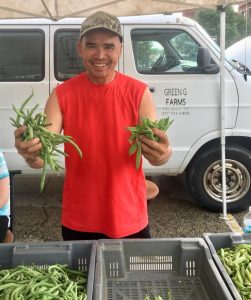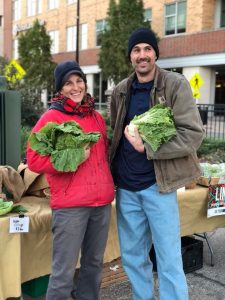The winding down of farmers market season always brings mixed emotions with it. On the one hand, it’s getting colder and colder each week and we’ve been at it for 6 months, and in some ways, we’re just ready to be done standing around a parking lot. On the other hand, though, we realize how much we’re going to miss seeing each other (vendors, customers, volunteers, and staff) every week, and how much we’re going to miss having ready access to this great food on a weekly basis. (Of course you can still get plenty of local food at Common Ground Food Co-op, the indoor Market in the Square in Urbana, Prairie Fruits Farm and Creamery’s The Real Stand, and other places, but still the offerings are a bit slimmer in winter).
 I’ve been working with farmers markets for about 8 years now, and lately I’ve been thinking about how much that has influenced what I buy and where. I’ve gone from appreciating farmers markets because of the taste and freshness to becoming pretty much incapable of buying produce out of season (I haven’t bought a peach or a tomato from a chain grocery store in who knows how long). And now I’ll really place seasonality and whether or not an item is produced locally above even price as a consideration when I go to buy food or coffee or gifts. Yes, in most cases this is probably going to be more expensive, and as someone who’s career has gone from teaching in Central Europe to adjunct teaching in the US to working for a non-profit, I’m not exactly swimming in extra cash. But the more I’ve gotten to know the farmers and food artisans I work with, I truly appreciate their hard work in getting their products to market, as well as how much more of an impact it has when I spend my dollars with them as opposed to a bigger chain store.
I’ve been working with farmers markets for about 8 years now, and lately I’ve been thinking about how much that has influenced what I buy and where. I’ve gone from appreciating farmers markets because of the taste and freshness to becoming pretty much incapable of buying produce out of season (I haven’t bought a peach or a tomato from a chain grocery store in who knows how long). And now I’ll really place seasonality and whether or not an item is produced locally above even price as a consideration when I go to buy food or coffee or gifts. Yes, in most cases this is probably going to be more expensive, and as someone who’s career has gone from teaching in Central Europe to adjunct teaching in the US to working for a non-profit, I’m not exactly swimming in extra cash. But the more I’ve gotten to know the farmers and food artisans I work with, I truly appreciate their hard work in getting their products to market, as well as how much more of an impact it has when I spend my dollars with them as opposed to a bigger chain store.
 And it’s all kinds of factors that have led me to value spending my money locally–not just taste or how much I like the vendor. It’s knowing how they’re willing to come out and set up a stand while shivering in the rain, even knowing that not that many shoppers might brave a stormy market day. Or talking with vendors who are so busy trying to build up their brand than they barely sleep, but still come out every week even if sales are risky or disappointing, because they know they’re building up their customer base one by one. The risk of setting up at an outdoor market week after week can be a big one, and many, many more hours of work go into selling at a market than just the hours we’re open.I want to make selling at a market worth their while as much as I can, and lately I’ve realized that part of this drive stems from understanding the hardships that go along with selling at a market just as much as the positive connections (taste + how much I just love these people). So I thought I’d turn the blog over to some of our farmers as well and let them share some of the experiences you don’t normally hear about, to give you a little more insight into the experience of a farmers market vendor.
And it’s all kinds of factors that have led me to value spending my money locally–not just taste or how much I like the vendor. It’s knowing how they’re willing to come out and set up a stand while shivering in the rain, even knowing that not that many shoppers might brave a stormy market day. Or talking with vendors who are so busy trying to build up their brand than they barely sleep, but still come out every week even if sales are risky or disappointing, because they know they’re building up their customer base one by one. The risk of setting up at an outdoor market week after week can be a big one, and many, many more hours of work go into selling at a market than just the hours we’re open.I want to make selling at a market worth their while as much as I can, and lately I’ve realized that part of this drive stems from understanding the hardships that go along with selling at a market just as much as the positive connections (taste + how much I just love these people). So I thought I’d turn the blog over to some of our farmers as well and let them share some of the experiences you don’t normally hear about, to give you a little more insight into the experience of a farmers market vendor.
 David Wickboldt (Havilah Gardens Micro Farm – Bellflower, IL)
David Wickboldt (Havilah Gardens Micro Farm – Bellflower, IL)
The hardest part of selling at a farmers market is “not knowing how many people we get to serve. I so appreciate the customers who come out and do their shopping at market every single week, rain or shine, cold or hot. We bring a lot of goods to market because this is how we make our living; and when people choose to make the farmers market part of their weekly shopping routine and let us know how much they appreciate the fresh food, that makes every long hour of labor worthwhile.”
Traci Barkley (Sola Gratia Farm – Urbana, IL)
“Almost everything we bring to the Tuesday market was harvested, washed and packed within 24-30 hours. Can’t beat that for freshness! That also means that we have a whole lotta perishable product that needs to find its way to a home or belly ASAP. When our customers come to market weekly rain or shine, it means the world to us! When they don’t, the dark cloud of wasted product and time, lost revenue and sore muscles rears its ugly head.”


